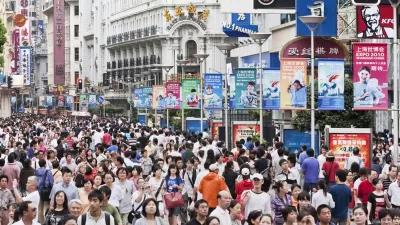Though China's cities have been growing exponentially, some argue it isn't urbanizing fast enough. Fearing Latin American-style slums, leaders have restricted migration. They're now being urged to ease controls to maximize agglomeration effects.
Though China's leaders have long sought to limit urban migration out of a fear of creating slums or "spurring centers of political opposition", according to "urbanization specialists" inside and outside outside of the country, "[t]he problem with Beijing, Shanghai and other Chinese megacities...is that they aren't even more densely packed—or better planned," writes Bob Davis.
"China's government hasn't bought into the bigger-is-better argument so far, but it is listening to new ideas. The country's new premier, Li Keqiang, who has made urbanization a focus of China's economic reform plans, said the government had received 500 proposals on the subject at a March meeting of the largely ceremonial parliament."
"'We have to let the market play a bigger role in the development of cities and dismantle barriers' to urban growth, said He Fan, a senior economist at the Chinese Academy of Social Sciences, the government's most prestigious think tank. 'People prefer to move to larger cities because there is more opportunity there.'"
"Yukon Huang, a former China director for the World Bank, estimates that if such restrictions were eliminated, about 60% of China's population would now live in cities, rather than the current 52.6%."
FULL STORY: Beijing Puzzles Over Urban Growth

Study: Maui’s Plan to Convert Vacation Rentals to Long-Term Housing Could Cause Nearly $1 Billion Economic Loss
The plan would reduce visitor accommodation by 25,% resulting in 1,900 jobs lost.

North Texas Transit Leaders Tout Benefits of TOD for Growing Region
At a summit focused on transit-oriented development, policymakers discussed how North Texas’ expanded light rail system can serve as a tool for economic growth.

Why Should We Subsidize Public Transportation?
Many public transit agencies face financial stress due to rising costs, declining fare revenue, and declining subsidies. Transit advocates must provide a strong business case for increasing public transit funding.

How to Make US Trains Faster
Changes to boarding platforms and a switch to electric trains could improve U.S. passenger rail service without the added cost of high-speed rail.

Columbia’s Revitalized ‘Loop’ Is a Hub for Local Entrepreneurs
A focus on small businesses is helping a commercial corridor in Columbia, Missouri thrive.

Invasive Insect Threatens Minnesota’s Ash Forests
The Emerald Ash Borer is a rapidly spreading invasive pest threatening Minnesota’s ash trees, and homeowners are encouraged to plant diverse replacement species, avoid moving ash firewood, and monitor for signs of infestation.
Urban Design for Planners 1: Software Tools
This six-course series explores essential urban design concepts using open source software and equips planners with the tools they need to participate fully in the urban design process.
Planning for Universal Design
Learn the tools for implementing Universal Design in planning regulations.
City of Santa Clarita
Ascent Environmental
Institute for Housing and Urban Development Studies (IHS)
City of Grandview
Harvard GSD Executive Education
Toledo-Lucas County Plan Commissions
Salt Lake City
NYU Wagner Graduate School of Public Service




























